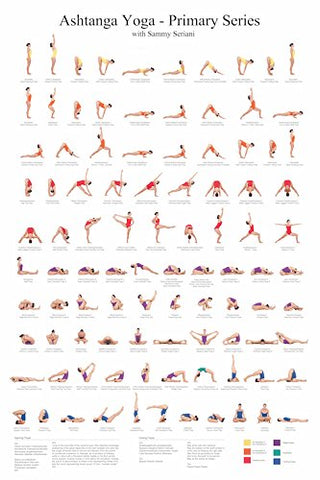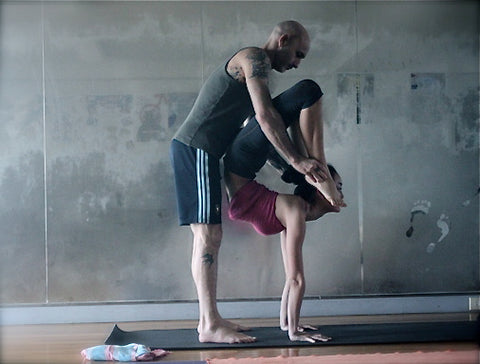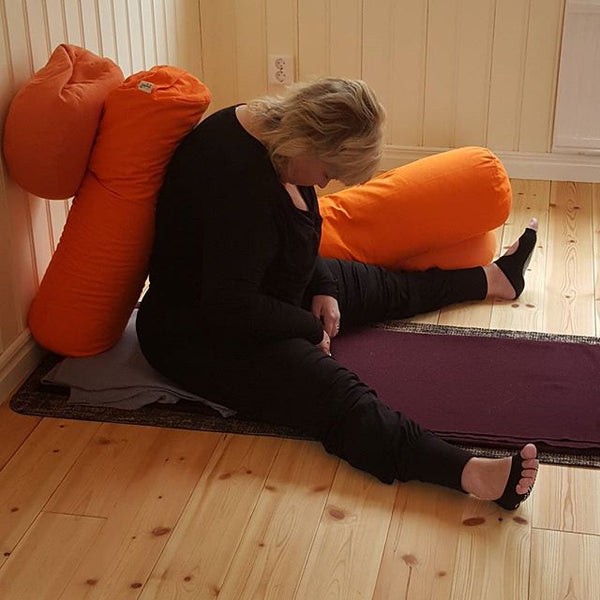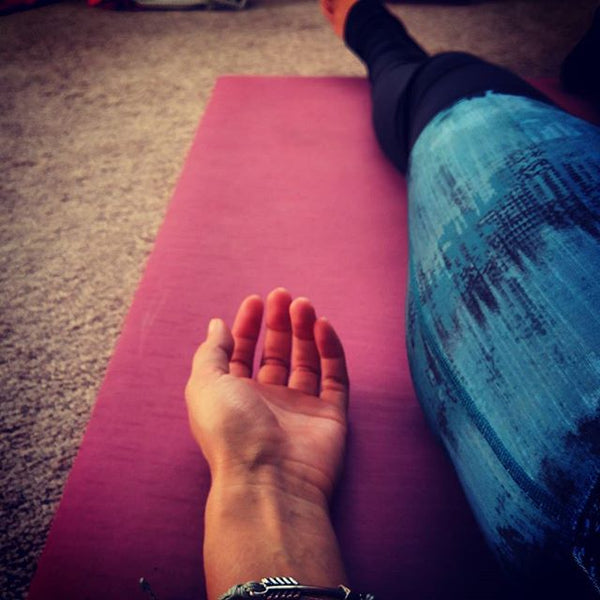Ashtanga Yoga: 10 reasons why we can't live without it
New to Ashtanga yoga? Looking for top tips for Ashtanga yoga practice? Here is a collection of ten things we wish we knew before embarking on this special practice that is loved and practised by many fellow yogis worldwide.
1. Ashtanga yoga is systematic

Picture via Barry Silver
Ashtanga yoga (or Ashtanga Vinayasa Yoga) was developed and popularised by the late Krishna Pattabhi Jois since the 1940s. Jois developed Ashtanga Yoga not just as a sequence of postures, but a system that combines the use of sequences of postures (asanas), breathing techniques (pranayama), use of internal muscles (bandhas) and gaze points (dristis) for focus. At first, Ashtanga Yoga can feel a bit intimidating (how can I remember all these postures while looking at the right spots and breathing in the right way?). Fear not. A good Ashtanga teacher breaks down the sequence and will teach you one posture at a time, until you are ready to learn more. However in a big led-class, you may receive less individual attention that you need before you get a hang of the flow and the speed of the practice. If you find it hard to keep up, it is perfectly normal. It may be worth it to first sign up for an Ashtanga beginner course before you join a group class, or to attend a 'Mysore' style class - which leads us to the next point.

Ashtanga Primary Sequence Poster available via Amazon
2. Ashtanga Yoga encourages morning self practices with the guidance of your teacher
Because of the sequenced nature of Ashtanga yoga, there are many ways to learn the practice. As a beginner, you may want to check out the following options:
Option (1): Attend a beginner's Ashtanga course that usually consists of weekly classes of 5-10 weeks to learn about the basics.
Option (2): Attend a 'Mysore' morning practice. You may see that for some yoga studios and gyms, there is an early practice option (and occasionally evening) called Mysore practice. Mysore is actually the founding location of Ashtanga yoga, and that in the ashram in Mysore, students usually drop in during early mornings within a given period to practice Ashtanga yoga through the guidance of the resident teachers. In modern day studios, the time frame is usually set between 6am-10am and you can drop in any time and leave any time. If you are new to the practice or the studio, a good teacher will greet you and adapt the practice for your level. A lot of practitioners swear by Mysore self-practice as the group energy in the room is usually very focused and inspiring, and also you get the attention of the teacher for poses you need the most.
Option (3): Attend a led, mixed-level class. It is always a good idea to suss out which options work best for you, however it is important to note that there are people who get frustrated when they choose option (3) as their first exposure to Ashtanga. Because everyone has a different body and that a led-class only provides on speed for all those postures, as a beginner to Ashtanga or a complete beginner to yoga, it can sometimes be too much. To give Ashtanga yoga a fair chance, you may want to start with option (1) or (2).

3. Hands-on, physical adjustment is integral to Ashtanga yoga practice
One very unique trait of Ashtanga yoga is that teachers in Ashtanga yoga provide hands-on, physical adjustments. In a led-class, you will experience less adjustments, as a teacher needs to take care of a whole class of students while leading the class verbally and demonstrating when necessary. But in traditional Mysore practice, a teacher will learn and observe the body type of a student, and provide necessary adjustment through the use of his/her own body as leverage and props.4. Ashtanga yoga is about a huge international community of practitioners
One thing I really like about my own Ashtanga yoga practice is that my teacher is very dedicated to his practice and he is also a very compassionate practitioner. Whenever he could find time, he would visit Mysore to deepen his practice. The dedication is both inspiring and infectious. Throughout the years I started meeting more Ashtanga yogi devotees, and it is a very moving, almost religious (in terms of vigor and passion) community for the practice. Check out the following videos to find out more about the practice:5. Depending on how you count, there can be 3-6 series of Ashtanga yoga
And they are absolutely mind-blowing:6. You will be given what is perfect for your body
In traditional Mysore practice, teachers will only give you poses that are suitable for you. Only when you start mastering the postures will you be given new ones. This ensure you do not overextend yourself and have super strong foundation for further advancements. Lots of Yoga recently had a chat with Mysore trained Sofia Xirotiri. Despite being a professional gymnast, Sofia also experienced poses that were challenging to her, and had to work hard to build up to the full sequence. How did she do that? Perhaps what differentiates ashtanga yoga from the other yoga forms is the strong emphasis that one should get on their mat 6 days a week. So, a 6-day-a-week practice, with one rest day... for life. Got it.7. Opening and Closing Prayer
Sometimes you may hear some practitioners humming to themselves before and at the end of their practice. They are humming the opening and closing prayers of Ashtanga yoga. The meaning behind the prayers are just lovely. However, if you are like us who have not committed the prayer by heart yet, fear not, we got the video and script here for you for the opening prayer (which is our favourite) from the lovely Joey Miles: Closing Prayer: स्वस्तिप्रजाभ्यः परिपालयंतां न्यायेन मार्गेण महीं महीशाः svasti-prajā-bhyaḥ pari-pāla-yaṁtāṁ nyāyena mārgeṇa mahīṁ mahīśāḥ May the well-being of all people be protected By the powerful and mighty leaders be with law and justice. गोब्राह्मणेभ्यः शुभमस्तु नित्यं लोकाः समस्ताः सुखिनोभवंतु ॥ go-brāhmaṇebhyaḥ śubham-astu nityaṁ lokāḥ samastāḥ sukhino-bhavaṁtu May good success be with all cows (divinity) and scholars May all (samastah) the worlds (lokha) become (bhavantu) happy (sukhino). ॐ शान्तिः शान्तिः शान्तिः auṁ śāntiḥ śāntiḥ śāntiḥ Om peace, peace, peace Imagine going in and chanting like pro. Not that we will ever, ever practise at home just to look good.8. The importance of Dristi
Ashtanga stresses the importance of using the correct Drishti while practicing. The Drishti is a gaze or focal point. There are 8 Drishti points and they are (from the bottom up) (1) feet, (2) naval, (3) thumbs, (4) tip of the hand (left or right), (5) far side (right or left), (6) tip of the nose, (7) in between the eyebrows (or the third eye) and (8) up to the sky. Each and every Ashtanga yoga pose has its own Drishti, i.e. Downward Dog’s is the naval and Baddha Konasana (Cobbler Pose) has the tip of the nose. The Drishti is used to help the body get into the correct alignment of the pose, to improve concentration and to help your Ashtanga practice stay the moving meditation that it’s supposed to be. It takes some getting used to at first, i.e. looking at your third eye may not be an every day thing for the layman, but you soon get used to it and discover its vast benefits.
Above is a beautiful demonstration of breath, gaze (Drishti) and movement in synchronisation. We don't know about you, but we are completely mesmerised! (Note: There is some discrepancy whether there are 8 or 9 Drishti points, simply because some choose to separate Far Left and Far Right. Not rocket science so you can take your pick whether you have 8 or 9 focal points!)
9. Ashtanga yoga can also mean the 8 limbs of yoga
This part is a little bit confusing because the term "Ashtanga yoga" usually refers to the form of yoga described above, populated by Pattabhi Jois and his students since his practice with Krishnamacharya from 1927. However, if you trace the origin of the word 'Ashtanga', you will find that it was a term coined by Patanjali's Yoga Sutras. The eightfold path is called Ashtanga, which literally means 'eight limbs'. They are 8 different sets of practices and principles to observe by in order for one to reach the true state of being. You can read more from this Yoga Journal article. Hence, sometimes people decribe Pantanjali's 8 limbs of Yoga as Ashtanga yoga, and the system developed by Jois as Ashtanga Vinayasa Yoga to differentiate the two.10. The dark side of injuries
First of all, we love Ashtanga yoga and we don't want to badmouth the practice. But after speaking to many friends of Ashtanga and from what we've learnt, injuries are not uncommon. A friend of Lots of Yoga once had a teacher who pushed her so hard that her hamstrings snapped, and it took her months to rehabilitate. Another proud found story is the former Ashtanga yoga teacher, Diane Bruni. We learnt from Matthew Remski's post that Diane describes her practice as religious and addictive: she had to practice 2-3 hours per day, six days per week. Despite her knee pain, she listened to her fellow Ashtanga teachers "to break your knees" and worked on hip openers. She took their advice and spent a year concentrated on hip opening poses. Whilst her knee pain stopped and her hips became very flexible, one day after another long session of applying a long hold, she stood up for an easy wide-legged forward bend, and heard four sharp pops from her right ilium and ischium as four separate muscle attachments tore away from her bones. You can view the full interview here: Ouch. That's got to hurt. Long and short of it, do try to practise with mindfulness and compassion! And yes, after reading this, the Lots of Yoga team still practises Ashtanga and are loving it. However, we tend to mix it up with other styles and forms of exercise to get a balanced yoga 'diet'. Those are our top insights. Surely we must have missed something important? If you are still here, we would love you to help us by sharing your practice here with your comments below, or even photos/videos to help other yogis discover this wonderful practice. Thank you! Po and Kat Team LotsofYoga x P.S. If you want more information, here are further references on Ashtanga yoga:- More about the Shri K Pattabhi Jois Ashtanga Yoga Institute.
- A great Pinterest board with all things Ashtanga.
- Ashtanga yoga as described by Wikipedia and Yoga Journal. Also check out this very well thought-out, potentially controversial piece on what Ashtanga yoga means to a long-term practitioner, Norman Blair.
- I love videos from David Swenson - I used to fall so behind in my first Ashtanga classes and I used David's videos to get familiarised with the sequence before I stepped back into the studio again. And it worked!
- Found this lovely blog on this lady's personal Ashtanga journey - heartfelt and humble, it is inspiring and warming.
- Featured image of this post is from Cathy Pastorek Woods' blog. Check out her wonderful blog here: and she can be followed via twitter.
- An interesting blog post: Is Ashtanga dangerous? Best bits in the comment section.
- For those of you who thought that women have less upper body strength or are more used to seeing men demonstrating advanced Ashtanga postures, here's a treat for you! Laruga Glaser's YouTube channel features some amazing moves through 15+ years of daily practice. Such as this one:
(Whoa...)
P.P.S. Here's a beautiful interview with Laruga on her personal journey to Ashtanga. My favourite quote:
"Encountering the unknown and opening up to our inherent potential is much more than simply bending the body. It is within the daily discipline that this potential awakens as it points us to a more fulfilling place than we could ever imagine for ourselves." - Laura Glaser



